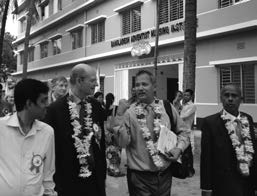Seventh-day Adventist students who wish to become nurses no longer face a Sabbath conflict with the opening of the church’s first nursing school in Bangladesh.
The three-story facility that houses the Bangladesh Adventist Nursing Institute was funded in part by a Thirteenth Sabbath Offering and stands on the campus of the Bangladesh Adventist Seminary and College in Gowalbathan Kaliakoir, a town located a two-hour drive from the country’s capital, Dhaka.
“This place will send hundreds of missionaries all over this vast and mighty country, and it will be a blessing from heaven,” Adventist Church president Ted N. C. Wilson said at a ribbon-cutting ceremony for the nursing school in late 2016. “May God bless this nursing college.”
The school, which has room for 100 students, opened for classes in 2017.The new building—with 10 classrooms, four laboratories, a conference room, and other facilities—received USD 150,000 of its 400,000 price tag from a Thirteenth Sabbath Offering given by church members worldwide in third quarter 2015, said Myrun Ju Lee, president of the Bangladesh Adventist Seminary and College. Another 100,000 came from the Adventist Church’s Southern Asia-Pacific Division, whose territory of 14 countries includes Bangladesh, and the rest came from individual donors in South Korea.
Saw Samuel, president of the Southern Asia-Pacific Division, described the establishment of the nursing school as a remarkable accomplishment that would not have been possible without the Thirteenth Sabbath Offering.
“This is a milestone,” Samuel said. “This is the first Adventist health training institute in Bangladesh.”
The school also offers local Adventist students the opportunity to study nursing in their own country.
“It is really important for our school here in Bangladesh to be able to have a school of nursing because there is no place where an Adventist young person can go to school to take nursing without having to go to school on Sabbath,” said Kevin Costello, associate executive secretary at the division. “Now we will finally have a facility that will be open and available for them so they can get a nursing degree and honor God on the Sabbath as well.”
Thank you for your mission offerings that helped make it possible to open the Bangladesh Adventist Nursing School.

